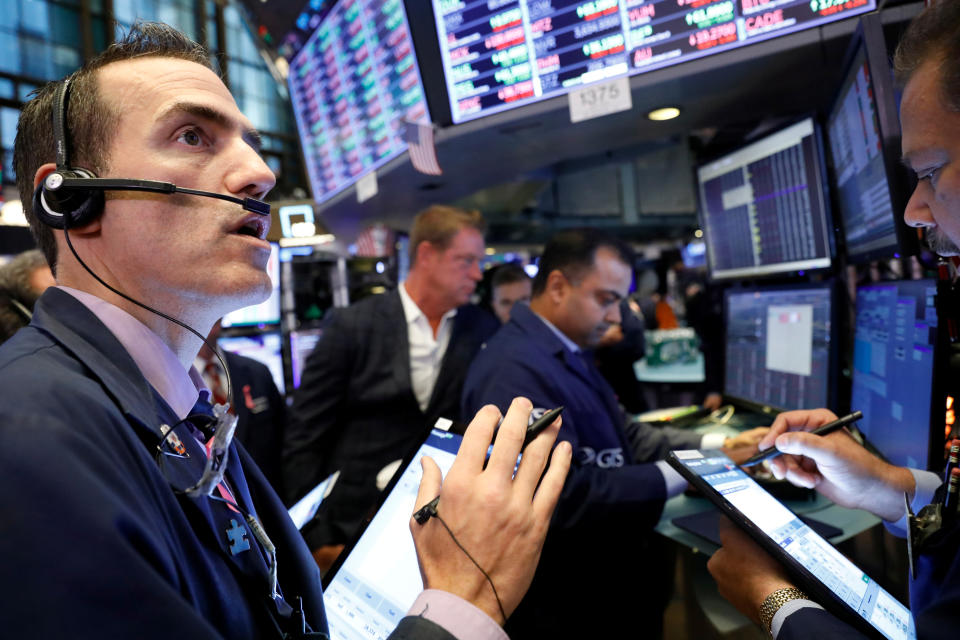Stock market news: October 4, 2019
U.S. stocks rose Friday after the September jobs report showed the unemployment rate fell to a fresh five-decade low, even as new job additions and wage gains missed expectations during the month.
By the end of Friday’s session, the S&P 500 and Dow had each posted their best session in seven weeks, while the Nasdaq rose the most in nearly one month.
Here were the main moves in the market by the end of regular equity trading:
S&P 500 (^GSPC): +1.42%, or 41.38 points
Dow (^DJI): +1.42%, or 372.68 points
Nasdaq (^IXIC): +1.4%, or 110.21 points
U.S. crude oil prices (CL=F): +0.7% to $52.81 per barrel
10-year Treasury yield (^TNX): -1.4 bps to 1.522%
Gold (GC=F): -0.23% to $1,510.30 per ounce
Data released throughout the week underscored a growth slowdown that had broadened out across the U.S. economy. These results sent the three major U.S. stocks reeling, although two days of gains helped offset some declines from earlier in the week. The S&P 500 slipped about 0.3% over the course of the week, the Dow fell nearly 1%, and the Nasdaq edged up about 0.5%.
Against this backdrop, the Department of Labor’s September jobs report provided mixed signals over the pace of economic growth going forward.
The U.S. economy added 136,000 new payrolls in September, missing expectations for 145,000, according to Bloomberg-compiled estimates. Friday’s jobs report also saw August’s payroll additions revised up to 168,000, from the 130,000 previously reported. July’s job gains were revised up by 7,000 to 166,000.
And on another positive note, the unemployment rate fell to a fresh five-decade low of 3.5%, the lowest since December 1969. Consensus economists had expected the unemployment rate to hold at 3.7% for a fourth consecutive month.
Average hourly earnings, however, were flat on a monthly basis. Hourly wages climbed just 2.9% over last year in September, versus consensus expectations for these to have risen 3.2% to match August’s rate.
Ahead of the September jobs report, ADP/Moody’s private employment print Wednesday showed that private employers added just 135,000 roles for the month, missing Bloomberg-compiled consensus expectations by 5,000. While the ADP/Moody’s survey has typically been an imprecise predictor of the absolute job gains in the “official” DOL report, it has captured a downtrend in private hiring growth also been reflected in the DOL releases over the course of this year.

The DOL’s jobs report comes three-and-a-half weeks before the Federal Reserve’s next rate-setting meeting. Market participants broadly expect policymakers will cut benchmark interest rates for a third time this year at the close of the meeting. A tepid jobs report, in combination with other softening data, could bolster the case for easier monetary policy.
“The September jobs report is consistent with an economy that is slowing, but not falling into recession. Combined with upward revisions to the prior two months, the employment picture remains relatively healthy,” David Donabedian, chief investment officer of CIBC Private Wealth Management, wrote in an email Friday. “The decline in the unemployment rate to 3.5% - a 50 year low – will also be noted as a sign of strength. However, we don’t think this report will change the likelihood of a Fed rate cut on October 31.”
Thursday’s rebound in stocks came even after the Institute for Supply Management reported weaker-than-expected growth in U.S. service-sector activity. While the release triggered an immediate sell-off in stocks – as had a report earlier in the week showing deteriorating domestic manufacturing activity – equities did return to the green shortly thereafter, which many took as a sign of increased expectations that the Fed would step in to lower rates amid the negative data.
Friday afternoon amid the jobs report, Federal Reserve Chair Jerome Powell delivered public remarks saying the economy “faces some risks” but is still overall “in a good place.”
“Our job is to keep it there as long as possible,” Powell said in prepared remarks. “While we believe our strategy and tools have been and remain effective, the U.S. economy, like other advanced economies around the world, is facing some longer-term challenges—from low growth, low inflation, and low interest rates.”
Powell said the central bank is “examining strategies” to help the central bank “symmetrically and sustainably” achieve its 2% inflation target.
Earlier during the session, Atlanta Fed President Raphael Bostic said during a discussion at Tulane University in Louisiana that further action by the Federal Reserve will depend on future data, with nearly a month to go until the next meeting.
“Depending on how things play out, there may be more we need to do,” Bostic said, according to a Bloomberg report.

—
Emily McCormick is a reporter for Yahoo Finance. Follow her on Twitter: @emily_mcck
Read more from Emily:
FedEx CEO: ‘Whistling past the graveyard’ on the U.S. consumer belies a broader slowdown
There won’t be ‘billion-dollar beverage brands’ in the future: Iris Nova CEO
Iris Nova CEO calls his company the ‘Netflix’ of the beverage space
Tech companies like Lyft want your money – not ‘your opinion’
Follow Yahoo Finance on Twitter, Facebook, Instagram, Flipboard, LinkedIn, and reddit.
Read the latest stock and stock market news from Yahoo Finance